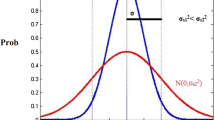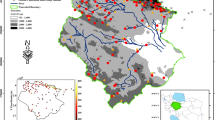Abstract
This paper reviews the sampling error formalism by North and Nakamoto (1989), North et al. (1991), and Yoo (2000) to provide an idea of optimal sampling design for rainfall field. Rain gauge networks, a line of rain gauges, microwave attenuation measurements, and satellite measurements are evaluated. Combined sampling cases using any two different sampling methods are also evaluated. All cases are applied to the GATE Phase I data, the same as in North and Nakamoto (1989), for the comparison. Summarizing the results is as follows. (1) Without any consideration of heterogeneities like orographic effect or diurnal cycle, the most economical rain gauge network becomes to use evenly spaced 16 gauges or satellite sampling every 24 hours for the sampling of 500km×500km area of GATE. For both cases the sampling error was estimated to be about 10% of standard deviation of areal average values. (2) The sampling error could be decreased significantly for the combined sampling of two different sensors, especially when they satisfy the condition for design orthogonality. For example, the sampling error is decreased up to 50% by combining the evenly spaced 16 rain gauges with satellite sampling every 24 hours.
Similar content being viewed by others
References
Atlas, D. and Ulbrich, C.W. (1977). “Path- and area-integrated rainfall measurement by microwave attenuation in the 1–3 cm band”,Journal of Applied Meteorology, Vol. 17, pp. 1322–1331.
Ha, E. and North, G.R. (1994). “Use of multiple gauges and microwave attenuation of precipitation for satellite verification”,Journal of Atmospheric and Oceanic Technology, Vol. 11, No. 3, pp. 629–636.
Nakamoto, S., Valdes, J.B., and North, G.R. (1990). “Frequency-wavenumber spectrum for GATE phase I rainfields”,Journal of Applied Meteorology, Vol. 29, pp. 841–850.
North, G.R. and Nakamoto, S. (1989). “Formalism for comparing rain estimation designs”,Journal of Atmospheric and Oceanic Technology, Vol. 6, pp. 985–992.
North, G.R., Shen, S.S.P., and Upson, R.B. (1991). “Combining rain gages with satellite measurements for optimal estimates of area-time averaged rain rates”,Water Resources Research, Vol. 27, pp. 2785–2790.
Polyak, I. and North, G.R. (1995). “Second-order climatology of GATE rainfall data”,Bulletin of American Meteorological Society, Vol. 76, No. 4, pp. 1035–1041.
Yoo, C. (2000). “On the sampling of rainrate field using raingauges and microwave attenuation measurements”,Stochastic Environmental Research and Risk Assessment, Vol. 14, No. 1, pp. 69–77.
Author information
Authors and Affiliations
Rights and permissions
About this article
Cite this article
Yoo, C. On optimal sampling design for rainfall field. KSCE J Civ Eng 10, 47–52 (2006). https://doi.org/10.1007/BF02829303
Received:
Accepted:
Issue Date:
DOI: https://doi.org/10.1007/BF02829303




